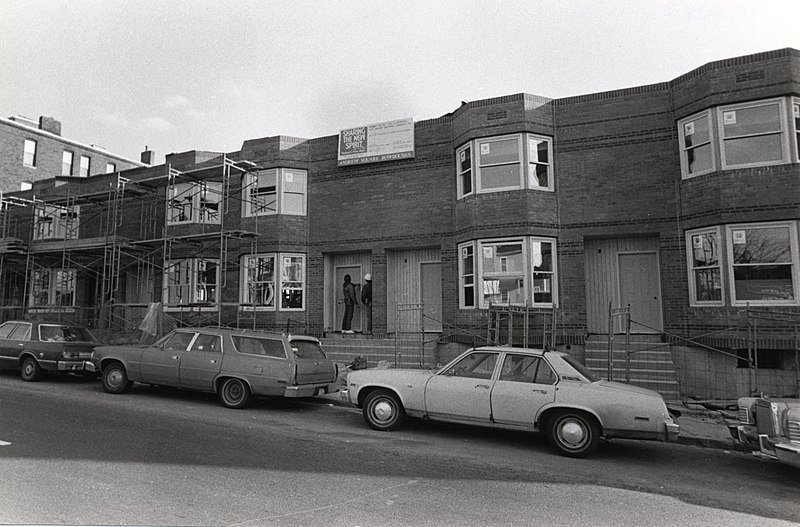
The Politics of Local Integration Governance
What do we know about horizontal governance relations at the local level? In general, local experiences exhibit two contrasting trends. On the one hand, there is a certain degree of local pragmatism by local governments in developing such relations, as non-public and private actors are key partners in the implementation of integration programs and the delivery of local social services. On the other hand, refugee integration has transformed small localities into battlegrounds with conflicts between pro-migrant non-public actors and local governments.

Exploring the Impacts of TOD Housing Stock and Built Environments on Housing Costs in Twenty-Six U.S. Metropolitan Areas
This paper contributes to the debates on housing supply efforts and the “missing middle” argument by examining the relationships between the share of metropolitan housing units in three types of compact transit-rich built environments and TOD housing rent. The census block groups of twenty-six U.S. metropolitan areas with intra-urban light, heavy, or commuter rail service were classified into six categories based on proximity to rail, housing density, and walkability: three rail-proximate built-environment types (high, moderate, and low density and walkability) and their three non-rail equivalents. Additionally, the studied metropolitan areas were grouped into three clusters based on housing and transit characteristics.

Local Social Service Organizations and their Relationship to Disadvantaged Neighborhoods
In our empirical study on “Radicalizing Spaces,” we examine whether disadvantaged neighborhood effects – operationalized in our case as susceptibility to radicalization – can be mitigated or even prevented by LSSOs. We focus our analysis on susceptibility to Islamist ideologies. The study was conducted in three German cities: Dortmund, Bonn, and Berlin. The survey was designed so that conclusions could be drawn about almost every district in each city. The topics of the survey focused on susceptibility to radicalization, participation in LSO services, and in-dividual attitudes and behaviors.

Spotlighting the Economy
In this article, “Spotlighting the Economy: Media Coverage and Mayoral Evaluations,” Burke shows that local newspapers are opinion leaders in the cities that they serve. I demonstrate that local newspapers help citizens hold their local governments accountable for economic performance. While a great deal of political science research has found that Americans hold their national government accountable for economic performance, only recently have scholars begun to examine the relationship between economic performance and citizens’ support for their city governments.

UAR Reading List: Gender, Race, and Electoral Politics
Following this weekend’s announcement that President Biden would not seek election, and the all-but-certain nomination of Vice President Kamala Harris secured for the Democratic Party, we assembled a reading list from the UAR archive. These articles address the issues of gender, race, and electoral politics (and their intersections) through the lens of urban studies and draw on a diverse range of methods. As the presidential election approaches, we hope to continue building out this list and solicit new research to examine these themes.

Mayors Unchecked
This article contributes urban politics literature on local democratic practices by studying mayors in one region of the world – Latin America – who in the last couple of decades have gained more prominence as political actors. This is primarily because decentralization as a popular trend has given local governments much more power, authority, and responsibility. In many cities across the region, we can point to mayors who have used their authority to do important things, including opening the budget to new forms of participation and providing services that are tailored to local priorities. In this article, however, we emphasize the opposite problem: mayors who govern using informal political practices that might be characterized as undemocratic.

Studentification and Political Displacement of the Black Worker Electorate
In this case study of university-driven gentrification in Philadelphia, I try to understand the extent to which gentrification driven by universities, or studentification, is related to the victories of progressive candidates and displacement of the Black electorate. Scholars of studentification have understudied its electoral impact. The analysis draws on census and voting data to examine the extent to which political wards that were once a stronghold of Black political power in Philadelphia have studentified, and whether studentified neighborhoods played a role in two elections that saw the unseating of long-time incumbents by progressive newcomers. In other words, this study is trying to get at whether studentification is correlated with political displacement of what W.E.B. Du Bois called “the Black Worker”.

Navigating the Complexities of Council Estate Regeneration
The redevelopment of Woodberry Down, one of the largest council estates in London, has been the subject of intense debate: touted in regeneration circles as a success story, critics have labeled it as yet another example of the pervasive state-led gentrification of London council housing. As we delved into the multifaceted story of Woodberry Down, we have uncovered a nuanced tapestry of victories and losses, forcing us to grapple with the question: is Woodberry Down an example of successful regeneration or is it yet just another casualty of “state-led gentrification”?

Compact City and Mayoral Entrepreneurship
The “compact city” is one of the key responses of urban policy for tackling the pressing challenges that cities are facing, such as environmental sustainability, economic viability, and social cohesion. Nonetheless, understanding Japan's compact city policies requires considering the historical trajectories of past events and decisions made by policymakers.

Transforming a Day-Laborer’s Quarter into a Service Hub
This study analyzes the transformation of Kotobuki in Yokohama, Japan, from a day laborers’ quarter to a service hub using public choice and neo-Hegelian theories. It aims to address gaps in understanding the role of city government in welfare provision, which has often been overshadowed by the focus on civil society’s contributions. By conducting in-depth interviews with city government officials and civil society personnel, the study explores Kotobuki’s unique evolution into a welfare center through the lenses of these analytical frameworks.

60.4
Issue 4 of our anniversary volume features an introductory essay by managing editors Maureen Donaghy (Rutgers University-Camden) and Yue Zhang (University of Illinois-Chicago). We revisit Larry Bennett’s “Harold Washington and the Black Urban Regime,” which was published in Urban Affairs Review in 1993.

Red, Blue, and Going for Gold
Hosting the Olympics in U.S. cities comes with unique challenges regarding planning and execution, given that due to the federalist system of government the responsibility of planning and hosting the games largely falls on state and local governments (Schimmel 2006). Many city officials now question the benefits of hosting the Olympics, given that many games have run over budget and residents of potential host cities have organized against the games, including recent bids from Boston and Chicago. Residents of Olympic host cities and potential host cities have expressed concerns regarding increased public spending, construction of Olympic facilities altering the public landscape, overcrowding, and gentrification of urban neighborhoods.

Tribal Politics or Discerning Voters?
The substantial influence of partisanship on voting behavior at the national level is widely studied and agreed upon. But to what extent does partisanship influence voting behavior at the local level? While some research indicates local elections may be similar to national elections in terms of partisan influence, there are reasons to be skeptical. Local elections typically are nonpartisan; even if they are not, issues may not fall neatly along party lines.

High and Dry
Recent hurricanes, floods, and wildfires across the United States highlight the devastating effect of climate change on individuals and households. Renters and households with low incomes are disproportionately exposed to and harmed by these disasters in many ways – but there are still open questions about the effects of these disasters, specifically on rents. On the one hand, disasters often lead people to leave affected areas, which may lessen demand for housing and lead to lower rents. On the other hand, disasters generally damage housing units, rendering some unusable, which may lower supply and lead to higher rents.

Collaborative planning in the context of deindustrialization
In the early 1990s, along the once-industrialized Mahoning River in Northeast Ohio, a small-town mayor faced a challenging set of forces when trying to solve local problems. With the steel industry long gone, the town’s future had been hindered by a series of low-level dams and industrial contamination in and along the river. These and other serious problems extended across the region – through other small, river-adjacent towns and nearby Youngstown.

60.3
Issue 3 of our anniversary volume features an introductory essay by managing editors Christina Greer (Fordham University) and Tim Weaver (University at Albany). We revisit Elinor Ostrom’s “The Social Stratification-Government Inequality Thesis Explored,” which was published in Urban Affairs Review in 1983.

Working in the crisis
While the COVID-19 pandemic was, first and foremost, a health crisis, it presented a profound challenge to local economies around the world. Day-to-day business was suspended, and employers were forced to adapt to rapidly evolving working conditions. An external, global pressure issued an abrupt shock to the economic system of communities. While certainly profound and currently the first-to-mind example of economic shock, it is just one of many global pressures that local economies have had to contend with. In the face of global forces, how do local economic practitioners react and empower their communities to shape their own economic destiny?

Reform and Community Level Participation
Eleven years after the official over turn of Stop, Question, and Frisk (SQF) in New York City there is still a debate about the appropriate ways for officers to interact with citizens on the street – and what information they have a right or obligation to record. How police stops impact citizens and their wider communities is of critical importance, but difficult to fully understand until long after policies have unfolded. However, within the bounds of privacy, detailed data on police actions and where they occur can provide the needed information to trace back how effective policy changes are and what consequences they have.

The Price of Losing Autonomy
Amalgamations have gained popularity worldwide as important strategies for enhancing administrative efficiency and addressing a variety of governance challenges, including fiscal constraints, demographic shrinkage, and fragmented urban governance. This trend has also spurred a surge in empirical research to assess the actual impacts of such territorial reforms across diverse political and social contexts. One noticeable pattern that emerges from the literature is that small and politically marginalized units are often underserved after amalgamations, as a result of their diminished political importance in the post-amalgamated jurisdictions.

Place-Based Policy and Neighborhood Business Density
Economic disparities within cities and across regions have long posed challenges for policymakers aiming to revitalize struggling communities. For decades, the Community Development Block Grant (CDBG) program has been a cornerstone of place-based investment strategies in the United States, offering local governments flexible funds to improve economic and social conditions in low-and-moderate income communities.